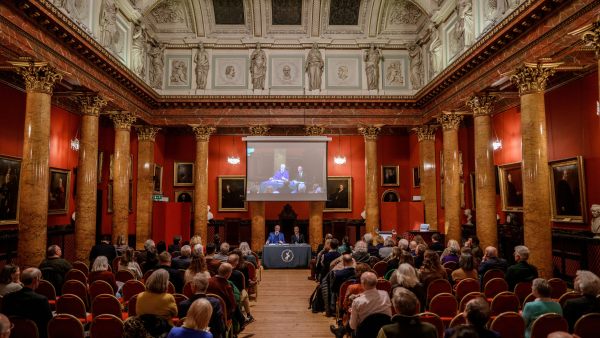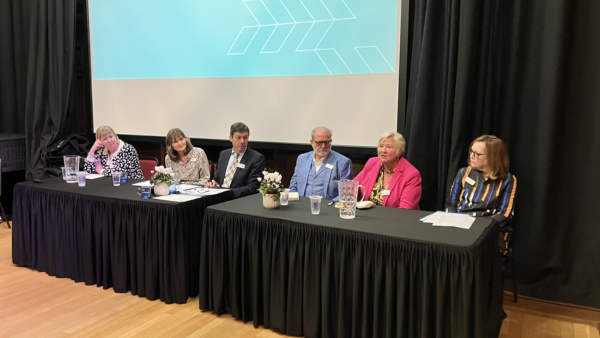The loss of an address can be a crippling blow for those who need support.
Sudden homelessness leaves people without a key form of ID they need to access services. As the fallout of the pandemic looks set to inflict this problem on more people, the time for a solution is now.
ProxyAddress can be that solution. It lets people without an address ‘borrow’ one from an unoccupied building. Helping them access services and reduce stigma. Thanks to support from an RSA Cataylst grant, we have grown and have now won an Innovation in Politics Awards for Human Rights.
The problem
A year before I was introduced to James, he was a 32-year-old married man with a full-time job and a two-bedroom flat. The day we met on a condensation-soaked bench in Clapham he was a 33-year-old unemployed, homeless widower.
James’ turning point came suddenly: his wife’s short battle with cancer; the loss of a job when caring for her took too much; the eviction when he could no longer afford to rent their flat on his own. He didn’t see homelessness as a possibility until he was already in its shadow.
But James’ problems had just begun. Losing his flat didn’t just mean just losing his home, it also meant losing his address – a snippet of information invented to describe a location but which is now used to identify a person.
Without this de facto form of ID, he became invisible to the system and unable to access the support he needed. The safety net he expected to find essentially snatched away because of the very reason he needed it.
This cruel Catch-22 is not uncommon. I’ve met hundreds of people who have met the same fate in their time of need:
- those who have tried to keep their details up to date but found it impossible while living on friends’ sofas
- those who applied for Universal Credit but missed an appointment letter in the post and were sanctioned (the removal of all benefits for between one month and three years)
- those unable to open a bank account without a proof of address
- those turned away from a GP (despite NHS guidance to the contrary)
- those prevented from getting a job due to the stigma of a ‘care of’ address sent to a homeless shelter - the list goes on.
For James, the lack of a permanent address meant that after being stripped of his home, then his identity, he was left without any chance to get back on his feet.
Today, some of those who have lost jobs or exhausted their savings in the pandemic are being given temporary protection through emergency measures. But growing numbers of people find themselves in a state of precarity set to be exposed once these measures end.
Already, one in 200 people across the UK wake up homeless each day in the UK. ProxyAddress national research, undertaken during the pandemic, finds that more than 1 in 20 adults in the UK think homelessness is likely within the next six months, rising to 1 in 10 for those under 35.
Those who do fall into homelessness will find, like James did, that the protections they expect to find waiting for them are sorely lacking.
The solution
As an architect, I want to see our built environment support rather than marginalise those who live in it. But, while housing and wrap-around care is the ultimate strategy to tackle homelessness, it is not the architects who will determine what gets built - we will only design the buildings that others have decided will be made.
So, rather than wait for others to intervene, I decided to try to use my understanding of the city to find another way.
Having previously used special temporary ‘not yet built’ details on construction sites to coordinate deliveries to buildings that were yet to be given an address, I knew that the rigid systems that underpin our lives, and which we often take for granted, can be made flexible when enough pressure or consideration is applied.
It was with that in mind that, while a Designer in Residence at the Design Museum in 2017, I created ProxyAddress: a system to fix this persistent Catch-22.
ProxyAddress allows those facing homelessness to ‘borrow’ the address details of an existing property (typically vacant or in-construction) and use this to access vital services. This duplicate address is tied to the individual rather than a location, stepping in as a proxy to provide the information needed to access support and to do so in a standard legacy format capable of being used as normal. It is a consistent address that follows each person throughout their recovery journey, no matter how often they move.
All the ProxyAddresses are provided with explicit consent from property owners - including councils, housing associations, housing developers, private donations, and some of the 225,000 long-term vacant homes in England – and there is no impact on the original property’s credit score, value, or postal deliveries. From its inception, the system has been designed to protect against fraud - something which is currently being demonstrated in our first pilot under the observation of the Financial Conduct Authority.
Though the journey so far has included challenges (and with many more yet to come), it has been made possible by the support and assistance of crucial partners and supporters. ProxyAddress is fortunate to have partners in Barclays, Monese, Monzo, Ordnance Survey, The Big Issue, Crisis and many more.
But it is through the RSA Catalyst programme I was able to create the tools needed to communicate the system to those going through the toughest time of their lives.
And, with the support of an advisory board including Tom Copley, London’s Deputy Mayor of London for Housing, I’ve been able to develop it in such a way that it fits in to a wider strategy to help tackle homelessness.
With ProxyAddress, the measure of success is its impact for those who need it. If all this work results in just one person like James being given the opportunity to avoid, or recover from, homelessness then it will have all been worth it. But to do this takes the kind of partnerships and support that can make something greater than the sum of its parts. It was a wonderful surprise, then, when ProxyAddress was recently recognised alongside Tom Copley as the winner of the Innovation in Politics Awards for Human Rights. Decided by over 1,000 citizens across Europe, it gives a great boost to our plan to make ProxyAddress available nationally.
But more than that, it was a moment to celebrate a new way to help alleviate some of the pressures faced by those most in need of help and, we hope, the beginning of the end for a system in which the loss of a home also means the loss of support.
Chris Hildrey is founder of ProxyAddress.
Related articles
-
The 2024 Angus Millar Lecture
Fellowship news
Fionna Monk
The 2024 Angus Millar Lecture was led by award-winning novelist Andrew O’Hagan on the theme of 'Art, Literature and Truth in the Era of Fake News, Algorithms and Artificial Intelligence'.
-
Facing the future: Scotland's challenges
Fellowship news
Fionna Monk
On 26 November 2024, RSA Scotland discussed Scotland’s future with nine engaging speakers addressing various challenges facing the country. The venue was resonant – a former committee room at the French Institute used in its early days by the Scottish Parliament. This successful event was chaired with deftness and humour by the former Presiding Officer at the Parliament, Rt Hon Ken Macintosh.
-
Improving health through economic development
Report
Anna Markland Liv Chai Nicholas Heslop
The RSA have created an Economies for Healthier Lives Programme Coaching Resource that pulls together our experience, insight and case studies from the five ‘Hubs’. This resource is designed to support those looking to learn from and replicate this work to get supported at every stage, from project inception through to legacy planning.




Be the first to write a comment
Comments
Please login to post a comment or reply
Don't have an account? Click here to register.